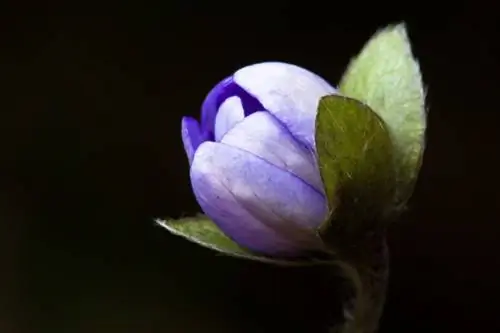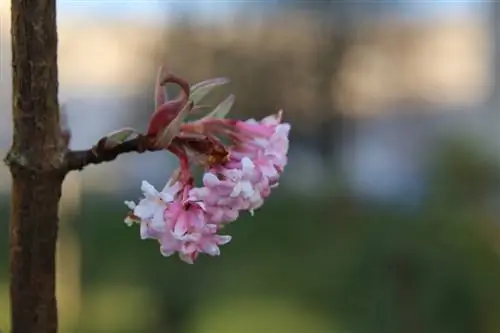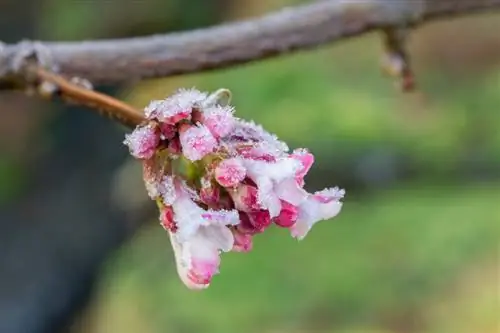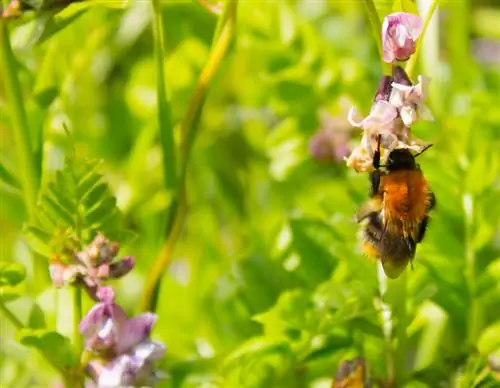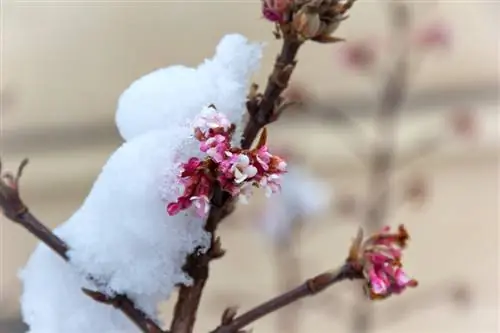- Author admin [email protected].
- Public 2023-12-25 17:45.
- Last modified 2025-01-23 11:21.
The gardener uses the term scented viburnum to mean various types of viburnum that stand out due to the intoxicating scent of their white or pink flowers. As a rule, they are deciduous, easy-care shrubs with broad bushy growth and early flowering: scented snowballs usually show their splendor in the months of March and April, but some open their spherical to umbrella-shaped flower umbels as early as November.
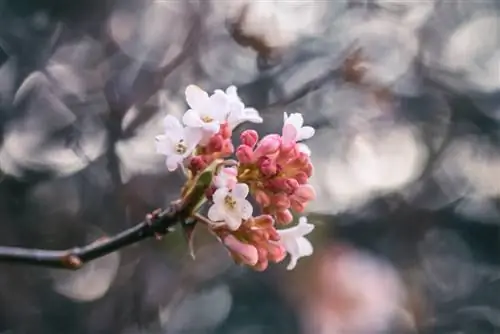
What characterizes the scented snowball?
The scented snowball is a deciduous shrub that stands out with its strongly scented, white or pink flowers. It blooms between March and April, is easy to care for and prefers a sunny to partially shaded location as well as humus-rich, fresh soil.
Origin and distribution
Most of the approximately 100 viburnum species come from East Asia, and the fragrant viburnum Viburnum farreri, which is often planted in German gardens, is no exception. This has its home in the northwestern provinces of China, where the climatic conditions are comparable to those in Central Europe. Here, in its wild form, the deciduous shrub, which is up to five meters high, can be found primarily on the edges and in the sparse mountain forests, where it prefers to grow on fresh, humus-rich soil.
The Viburnum farreri, often referred to as the scented viburnum, and the large-flowered viburnum (bot. Viburnum grandiflorum) are the two parent species of the hybrid form Viburnum x bodnantense, which is also known as scented snowball. However, the hybrid is better known under the name winter snowball, which it bears because of its extremely early flowering.
Usage
Plant the scented viburnum either in isolation - for example in the middle of a lawn or as the center or background of a herbaceous border together with phlox, delphiniums or bee balm - or in groups. When planting in a group, you can only plant one species together, for example as a flowering hedge, or with other trees such as rhododendrons, lilacs, dogwoods, clerical trees or a Japanese maple.
Appearance and growth
Basically, the scented snowball is one of the slow-growing trees, only growing about ten to 25 centimeters per year. When fully grown, the tightly upright growing shrub grows to around two meters high and two meters wide. The branches often overhang slightly, and over time the shrub develops numerous runners. Through these and ground shoots growing from the roots, the tree can easily cover larger areas. The crown is usually quite dense and the bark is typically slightly reddish in color. Older bark often flakes off in extremely delicate flakes.
leaves
Viburnum farreri is a deciduous shrub whose leaves take on a pretty red to deep purple autumn color in autumn. This is particularly effective against the evergreen background of a planting of rhododendrons. The leaves of the scented viburnum are arranged oppositely, lanceolate to elliptical in shape and usually pointed. They sit on reddish stems about two centimeters long. They are up to eight centimeters long and four centimeters wide.
Bloom and flowering time
The main flowering of the scented viburnum occurs between March and April, although in mild weather, isolated inflorescences open from the end of October / beginning of November throughout the winter. The buds have an intense pink color and are arranged like panicles at the ends of the short side shoots. However, the tubular flowers that open from it are colored white. They have an elongated shape and can be about one and a half centimeters long. The scented snowball has its name for a reason: its flowers exude an intense smell that most people find pleasant and can be noticed from just a few meters away.
Fruits
Since there are no bees, bumblebees, etc. buzzing around in our latitudes during the flowering period of the scented viburnum, fertilization only rarely occurs - which means that fruits are also unlikely. If they do develop, they will have an elongated shape and have a green to reddish tint. You should also exercise caution in such a case, the fruits of the scented viburnum are slightly poisonous.
Toxicity
In addition to the fruits, the entire plant is considered to be slightly poisonous, although there are no serious consequences due to poisoning. In extreme cases, nausea, diarrhea and/or vomiting may occur.
Which location is suitable?
The scented snowball prefers to be in a sunny to partially shaded location where it can bathe in full sunlight for a few hours a day. Here the shrub produces a particularly large number of flowers, as long as the selected location is protected and not at risk of late frost - the open flowers cannot tolerate severe frost. It is best to plant the tree near a protective wall or directly in front of a hedge, as long as it is not too shady there. If the location is too dark, the blossoms of the scented snowball will be noticeably sparser, and the otherwise intense autumn colors will also be weaker.
Floor
However, the scented snowball is quite undemanding when it comes to soil conditions. The shrub feels most comfortable in a fresh to moderately moist subsoil rich in humus and nutrients, but which is loose and deep. Although the plant needs an evenly moist location, it cannot tolerate waterlogging. In this respect, you should thoroughly loosen clayey soil before planting and, if necessary, incorporate drainage. It also makes sense to improve the soil with plenty of compost at every location - the scented snowball has a high nutrient requirement. The shrub is very adaptable when it comes to pH.
Plant scented snowball correctly
Although Viburnum farreri is usually sold in containers and can therefore generally be planted at any time, experts still recommend planting it in spring. This is an advantage because the shrub has enough time to become thoroughly rooted before the first winter and therefore has a better chance of surviving the cold season unscathed. In addition, if limitation is desired, you should also use a root barrier, which should have a diameter of at least 150 centimeters. The scented snowball likes to spread over foothills and can therefore take up larger areas over the years. It also makes sense to add well-rotted cattle manure or leaf humus to the soil before planting.read more
Pouring scented snowball
The scented snowball needs an evenly moist surface to thrive, which is why you should not let planted specimens in the garden dry out. Therefore, make sure you drink enough water during the hot summer months and longer dry periods - once every two weeks should be sufficient in such cases. Scented snowballs kept in pots must not dry out in summer and must not freeze in winter.
Fertilize scented snowball properly
If the scented snowball is placed in normal, humus-rich garden soil and was already given compost (€12.00 on Amazon) or stable manure when planted, it will do well even without additional fertilizer. However, if the shrub is on rather poor soil or shows signs of deficiency, you can remedy the situation with a commercially available garden fertilizer.
Cut the scented snowball correctly
The scented snowball is a pruning-tolerant shrub that should be regularly thinned out and cut into shape. Such pruning is best done immediately after flowering in March or April and stimulates the plant to produce new, strong growth and fresh shoots. Remove stray branches, dry or dead wood and dead inflorescences.
Propagate scented snowball
The easiest way to propagate the scented snowball is via runners, which it develops over time anyway. All you have to do is carefully dig them up, separate them from the mother plant and plant them separately. But the species can also be easily propagated using planters and cuttings, although cuttings are a little more complicated to root. On the other hand, you simply stick the sinkers into the ground in spring and cut them off from the mother plant as soon as the new plants develop their own shoots.
Wintering
The scented snowball is hardy and does not require any special winter protection. Only the flowers that open in mild weather are at risk of frost.
Diseases and pests
The scented snowball is comparatively insensitive to infestation by pathogens or pests. Infestations caused by powdery mildew (“fair weather mildew”) or leaf spot can occasionally become problematic, although both fungicidal diseases can be treated quite easily. Watering with a self-made decoction of field horsetail and comfrey not only provides the scented snowball with additional nutrients, but also effectively prevents fungal disease.
The species is also quite susceptible to infestation by aphids or the viburnum leaf beetle. Check the bushes regularly to counteract any invasion in good time.
Tip
You can also cut off inflorescences that are not yet fully open and place them in the vase. The branches will last for about two to three weeks (sometimes even longer) as long as you change the water daily and place the vase in a bright place.
Species and varieties
Various species and varieties of the genus “Schneeball” (bot. Viburnum) are called scented viburnum because almost all of them produce more or less strongly scented flowers. These are essentially two wild species and a cross between them, which in turn is offered in different varieties:
- Viburnum farreri: upright growing shrub, height up to three meters, white or pink flowers between January and March, summer green
- Viburnum carlcephalum: also large-flowered scented viburnum, broad bushy growth, height up to two meters, strongly fragrant flowers between the end of April and May, summer green
- Viburnum × bodnantense: also winter viburnum, scented viburnum or Bodnant viburnum, hybrid of the two species mentioned above or of V. farreri and V. grandiflorum, growth height up to 3.5 meters, white or pink Flowers usually between March and April
'Candidissimum': bushy growth, pure white, large inflorescences, particularly floriferous
'Dawn': upright, arching overhanging growth, whitish-pink flowers until around mid-April, depending on the weather Flowering is also possible from November
'December Dwarf': dwarf form with a maximum height of 150 centimeters'Fioretta': compact growth, pink flowers
In addition, the following viburnum species also have fragrant flowers:
- Viburnum carlesii: also Korean scented snowball or fragrant snowball, spherical to broad-bushy growth, maximum height of 150 centimeters, strongly fragrant, white-pink flowers
- Viburnum burkwoodii: also Easter viburnum, loose, broad-rounded growth, height up to 200 centimeters, strongly fragrant, white and pink flowers between April and May


